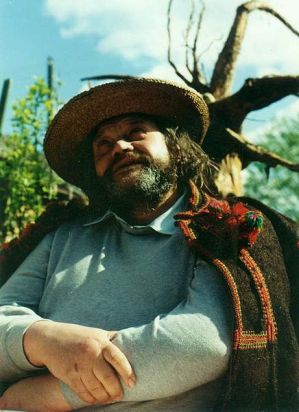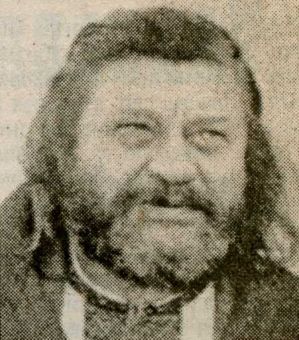Archeologist, historian, art historian, civic and political figure.
From a family that gave Ukraine many cultural and political figures. His father, Rev. Petro Gereta, was also known as a poet (under the pseudonym Oles Gereta) and composer. His mother, Yevheniya (née Skomorovsky), was a conductor of church choirs. The family had 11 children. During the German occupation, his father hid Jews.
In 1942, the family moved to the village of Velyka Berezovytsia, where his father received a new parish. Here, in 1955, Ihor graduated from secondary school (now Ternopil Secondary School No. 8). He studied at the Ternopil Music School. In 1957, he entered the history department of Chernivtsi University, stating in his autobiography that his father was a civil servant. During his student years and later, along with his brother Oleh, who studied at the Lviv Conservatory, he was a leader of a patriotically inclined, predominantly student circle that considered itself an organization. Among them were bandurist Mykola LYTVYN, poet Vasyl Yarmush, pharmacist Khrystyna Durbak (Kurkevych), economist Maria Tyvonyuk (Tebenko), financier Iryna Zahaliuk, music college instructor Metodiy Chubaty, and teacher Mykhailo Huralchuk. In this circle, samvydav literature was distributed, including “On the Occasion of the Pogruzhal'sky Trial,” “Ukrainian Education in a Chauvinistic Noose,” and “Address of Pope Paul VI.”
Beginning in 1962, after graduating from the university, Gereta worked as a senior researcher at the Ternopil Regional History Museum and, from 1965, as the deputy director for research. He contributed articles about cultural and scientific figures from the Ternopil region to oblast- and republic-level publications. Under a contract with the Lviv publishing house “Kamenyar,” he worked on a guidebook to the Ternopil region.
He was arrested on August 27, 1965, in Odesa, where he was on a business trip. Simultaneously, M. Chubaty and M. LYTVYN were arrested and accused of conducting “anti-Soviet agitation and propaganda” (Part 1 of Article 62 of the Criminal Code of the Ukrainian SSR). Since the investigation had no physical evidence of an organization's existence (on Gereta's advice, no one wrote anything down), M. LYTVYN was held for a month in the Ternopil KGB’s pre-trial detention center and then released without trial after an oath was extracted from him not to fight against the Soviet regime. The investigation into the case of Gereta and Chubaty lasted six months and also yielded nothing substantial: they had promoted cultural development, the idea of Ukrainian statehood, sang songs, and at a friendly gathering at Gereta’s on August 22, 1965, they spoke about the Russification of schools and the anthem “Shche ne vmerla Ukraina...” (“Ukraine Has Not Yet Perished...”). However, the arrested men pleaded guilty and confessed that they had received the articles “Ukrainian Education in a Chauvinistic Noose” and “Address of Pope Paul VI” from Mykhailo OZERNY.
The audience in the courtroom (February 1966) consisted of secretaries of Party and Komsomol organizations and the “aktiv” of the city and raions. Taking into account the defendants' remorse and their “cooperation in solving the crimes,” the court gave Gereta a 5-year suspended sentence and Chubaty a 4-year suspended sentence, releasing them in the courtroom. This meant they would have been imprisoned if they had committed a new “crime” during those years.
After the trial, Gereta was unemployed for several months and then worked at the Ternopil Regional History Museum for the rest of his life. Until Ukraine gained independence, he was deprived of the opportunity to pursue a scholarly and creative career. He was under constant surveillance by state security agencies and the Party apparatus.
Despite persecution and pressure, Gereta launched a vast body of scholarly work and, from the late 1980s, became active in public life. He was the founder and curator of several museums (of Solomiya Krushelnytska, Les Kurbas, Patriarch Josyf Slipyj, Volodymyr Hnatiuk), including the Historical and Memorial Museum of Political Prisoners in the basements of the former regional KGB administration building (1997).
In 1978, he founded an art club at the art gallery, which operated until 1985. He was a co-founder of the first opposition organization in Ternopil, “Ternove Pole” (Thornfield), as well as the Society for the Ukrainian Language and the V. Stus “Memorial” Society, among others. In 1991, he founded the Institute of National Rebirth of Ukraine (which now bears his name). He was the publisher of more than 30 books for the Institute. As an archeologist, he researched ancient monuments of Ukraine. He co-authored three academic monographs on the archeological sites of Prykarpattia and Volyn. He participated in local and international conferences on archeology, history, and art history. He authored over 120 studies and articles in encyclopedias, collections, and periodicals in Ukraine and abroad. He also wrote numerous literary works and a collection of poems, “A Slice of Sky” (1997).
From 1988–91, Gereta was a co-founder of the People’s Movement of Ukraine and a member of its Grand Council. He ran for the Verkhovna Rada of Ukraine (1994, 1998); he was a deputy of the Ternopil Oblast Council for four terms, serving as chairman of the commission on culture and spiritual revival. During the 1990 election, unknown perpetrators committed several demonstrative burglaries (stealing items found during excavations, a typewriter, and shoes from Gereta’s home) and vandalized a car his father had given him.
Gereta died on June 5, 2002, in Ternopil at his parents’ home on Hlyboka Street. He is buried in the cemetery in the village of Velyka Berezovytsia, Ternopil Raion.
He had two children: a daughter, Yaryna (b. 1971), and a son, Ustym (1972–1990).
The people of Ternopil honor Gereta as the founder and driving force behind many patriotic causes. On August 28, 2011, on Sahaydachny Street in Ternopil, an “Alley of Stars” was unveiled, and Ihor Gereta was among the first four figures immortalized.
Bibliography:
Chornovil, V. Woe from Wit. Lviv: Memorial, 1991, p. 35.
Chornovil, V. Works: In 10 vols. Vol. 2. “Justice or Recurrences of Terror?” “Woe from Wit.” Materials and Documents 1966–1969. Compiled by Valentyna Chornovil. Foreword by Les Tanyuk. Kyiv: Smoloskyp, 2003, pp. 264–265, 248–249, 265–267, 277, 384–385.
“A Column Has Fallen...: Ihor Gereta Has Passed Beyond the Threshold of Eternity.” Ternopilska Hazeta, June 12–18, 2002, p. 7.
Masliy, M. “He Was a Titan. Ternopil Bids Farewell to Ihor Gereta.” Nova Ternopilska Hazeta, June 12, 2002, p. 7.
“In Eternal Memory of a Brother-in-Arms.” Literaturna Ukraina, June 13, 2002.
Tkachyk, B. “His Figure Attracted Like a Magnet.” Ternopil Vechirniy, June 5, 2003; June 12, 2003, p. 6.
Okarynsky, V. “The Soul of the Ternopil Sixtiers.” Vilne Zhyttia, September 26, 2008.
Mykola Lytvyn. “Oh, the Red Viburnum in the Meadow.” Literaturna Ukraina, no. 41 (5279), October 23, 2008.
Volodymyr Mysyk. “The Formation of Ihor Gereta as a Personality, Public and Political Figure, and Scholar.”
http://www.nbuv.gov.ua/portal/Soc_Gum/NZTNPU_ist/2009_2/materialy/2009_2/Mysyk.pdf
Volodymyr Mysyk. “The Figure of Ihor Petrovych Gereta in the Context of the Development of Public and Political Life in the Ternopil Region in the Second Half of the 20th Century.” http://www.nbuv.gov.ua/portal/soc_gum/Ues/2009_3/Articles/3/Volodymyr%20Mysyk.pdf
Gereta, I.P. http://uk.wikipedia.org/wiki/Ґерета_Ігор_Петрович
The Resistance Movement in Ukraine: 1960–1990. An Encyclopedic Guide. Foreword by Osyp Zinkevych and Oles Obertas. Kyiv: Smoloskyp, 2010, pp. 136–137.

GERETA IHOR PETROVYCH

GERETA IHOR PETROVYCH